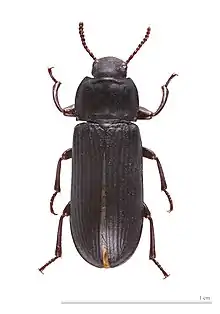Tenebrio
Tenebrio is a genus of darkling beetles.[2][3] Adults are 12–18 mm (0.47–0.71 in) long and can live for 1–2 years. The larvae are minor pests, but they are also widely reared and sold as pet food.[3]
| Tenebrio | |
|---|---|
 | |
| Tenebrio molitor adult | |
| Scientific classification | |
| Domain: | Eukaryota |
| Kingdom: | Animalia |
| Phylum: | Arthropoda |
| Class: | Insecta |
| Order: | Coleoptera |
| Infraorder: | Cucujiformia |
| Family: | Tenebrionidae |
| Tribe: | Tenebrionini |
| Genus: | Tenebrio Linnaeus, 1758 |
| Species | |
| |
Species
The genus contains the following extant species:[2][3][4]
- Tenebrio culinaris Linnaeus, 1758
- Tenebrio guineensis Imhoff, 1843
- Tenebrio giganteus (Gmelin, 1790)
- Tenebrio grandicollis (Fairmaire, 1897)
- Tenebrio molitor Linnaeus, 1758 – yellow mealworm
- Tenebrio obscurus Fabricius, 1792 – dark mealworm
- Tenebrio opacus Duftschmid, 1812
- Tenebrio patrizii Gridelli, 1958
- Tenebrio punctipennis Seidlitz, 1896
- Tenebrio zairensis Ferrer, 1998
Four species are known from fossils found in Germany and Canada:[1][5]
- Tenebrio calculensis Scudder, 1895 - (Pleistocene, Leda Clay, Canada)
- Tenebrio effossus Germar, 1837 - (Oligocene, Rott Formation, Germany)
- Tenebrio primigenius Scudder, 1879 - (Ypresian, Allenby Formation, Canada)
- Tenebrio senex Von Heyden, 1859 - (Oligocene, Rott Formation, Germany)
Gallery
.png.webp)
_(28872264321).png.webp) Tenebrio giganteus
Tenebrio giganteus Tenebrio opacus
Tenebrio opacus
References
- "†Tenebrio Linnaeus 1758". Paleobiology Database. Fossilworks. Retrieved 17 December 2021.
- "Tenebrio". Integrated Taxonomic Information System. Retrieved 4 January 2017.
- Rees, David (21 July 2004). Insects of Stored Products. CSIRO Publishing. pp. 112–113. ISBN 978-0-643-10263-7.
- "Genus Tenebrio". Insecta.pro. Insects catalog Insecta.pro, 2007—2022. 2017-08-16. Retrieved 2022-08-23.
- Scudder, S. H (1895). "Canadian fossil insects, myriapods and arachnids, Vol II. The Coleoptera hitherto found fossil in Canada". Geological Survey of Canada Contributions to Canadian Palaeontology. 2: 5–26.
This article is issued from Wikipedia. The text is licensed under Creative Commons - Attribution - Sharealike. Additional terms may apply for the media files.